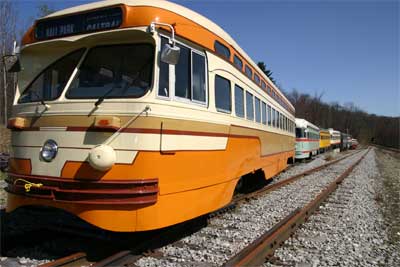 |
| As one of SFMTA's eleven streetcars selected for rehabilitation, this car was painted to adopt Cleveland's historic livery. |
Picture the streets of San Francisco or New Orleans and chances are old trolley and streetcar lines come to mind. In these cities, public transit takes on a meaning and purpose deeply embedded in city history. Sadly, many trolleys and streetcars are fading with their past, lined up, awaiting their fate on the scrap heap. Yet, these very streetcars are making a comeback, thanks in part to Brookville Equipment, a company dedicated in part to restoring trolleys and streetcars across the country-and bringing a piece of the past into the present.
Brookville Equipment Corporation (BEC), Brookville, PA, specializes in the development of transportation equipment for mining, tunneling, aviation ground support, industrial and switching locomotives and trolleys and streetcars. While its business has grown to include a diversified product line, their philosophy remains the same: BEC's history (since 1918) provides first-hand experience in developing transportation equipment that is innovative, cost-effective, maintenance and operator friendly, environmentally conscious and safety-minded.
History is the key, as Brookville relies on its 20+ years of history with Miller Electric Mfg. Co. for many of its welding needs. For welding on the trolleys and streetcars, many that have been idle, weathering the elements for years, Brookville operators depend on the portability, quality and increased productivity they get from the Millermatic® 251 all-in-one MIG welder, along with the CP-252 TS with 22-A wire feeder for spot welding and the Dynasty® 300 DX AC/DC TIG welder for its TIG welding needs.
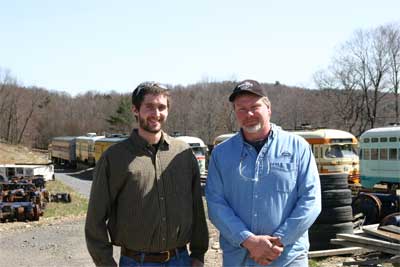 |
| Brent McNeil, Production Manager, and Gary Steele, Project Leader, stand in front of SFMTA streetcars lined up behind Brookville Equipment. |
Restoring the Past
In order to replicate streetcars from days gone by, Brookville designs and rebuilds the cars to retain a historical look but include new car comforts. The company has rebuilt, to varying degrees, streetcars and trolleys for the New Orleans Transit Authority (NORTA), Southeastern Pennsylvania Transportation Authority (SEPTA) and San Francisco Municipal Transportation Agency (SFMTA).
For NORTA, which has the deepest streetcar tradition in the United States, Brookville manufactured and installed the truck assemblies and propulsion equipment for 24 streetcars to operate along Canal Street, which borders the French Quarter. The streetcars are actually replica cars, meaning everything on the car is brand new but made to look like the old St. Charles streetcar (1920's Pearly A. Thomas streetcars). While Brookville handled the manufacture and on-site installation of the truck assemblies and propulsion systems, NORTA's skilled craftsmen and artisans built the car bodies from scratch.
In the case of Philadelphia (for SEPTA), the cars spent their whole lives on the street, resulting in a tremendous amount of salt spray damage and rust. Brookville completely disassembled and remanufactured 18 Vintage 1947 Presidential Conference Committee (PCC) trolley cars.
"At that time, nobody was taking a PCC car and stripping it down to the point that we did and rebuilding it," says Gary Steele, Project Leader. "No one thought it could be done."
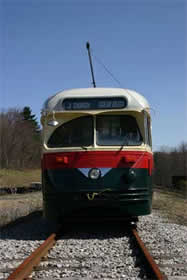 |
| The colors on this streetcar were chosen by SFMTA to echo Birmingham. |
From receiving the cars to painting them, Brookville did just that. The cars replaced the bus service operating between 63rd street and Girard Avenue, and Richmond and Westmoreland Streets in Northern Philadelphia. Additional features in the cars include: wheelchair accessibility, heating and air conditioning, newly designed interior passenger stop requests, a public address system, original art-deco style lighting and stainless steel seating with cloth upholstered inserts.
Currently, Brookville is rehabilitating 11 streetcars for SFMTA. The cars, built between 1946 and 1948 and formerly for use in the Newark subway, were purchased by SFMTA and sent to Brookville for restoration. Following exterior and interior rehabilitation, the cars will be delivered to San Francisco.
Homegrown Talent
While each project, depending on the condition of the cars and city transit needs, requires a wide range of jobs, every project requires a large amount of welding.
"It depends on the area, but, for example, in our framing department, operators weld from the time they get here until the time they leave," says Steele. "There's a lot of fabrication that goes on in the car body modification area, because after we cut a piece out of the car, we have to rebuild it in the fab shop before we can take it and weld it back in. I'd say we're welding on the trolleys 60 percent of the time."
With 130 employees and roughly 30 to 40 welders running two shifts, qualified welders can be hard to find; so the company has conducted an in-house welding class to convert some of its workforce that doesn't have welding training. Eight welders took the two-week course for three hours a night to pass their AWS D1.1 (structural steel) qualification. This way, the company creates welders with skills in other manufacturing areas as well.
The first phase is disassembly. Operators completely disassemble, grit blast, and prime the cars, they are then moved into the car body modifications area, where all rusted sections are removed and replaced.
Basically, phase one requires operators to re-build the car by cutting the rust out and replacing it with new steel. The steel, ranging from as thin as 22 gauge up to 3/8 in., is welded using .030-in. diameter solid wire. Because of the size of the car and amount of welding required, the Millermatic 251 is ideal.
"The 251s get used for basically anything we need to weld on the cars, the sheet metal and structural steel," says Steele. "The cars are big, so we have the Millermatics on wheels and can roll them around."
 |
| Gary Steele can easily move the Millermatic 251 around this streetcar to weld in any area. This car was painted to reflect the historic livery of the Newark Public Service Consolidated Transport. |
The Millermatic 251 welds metal 22 gauge to 1/2 in. thick in a single pass and has a 30- to 300-amp output range (250 amps at 40 percent duty cycle). The 251's patent-pending Active Arc Stabilizer control and adjustable run-in speed control start the arc more consistently than any comparable MIG welding machine.
"With the Millermatics, we can fine-tune the arc and eliminate 90 percent of spatter," says Steele.
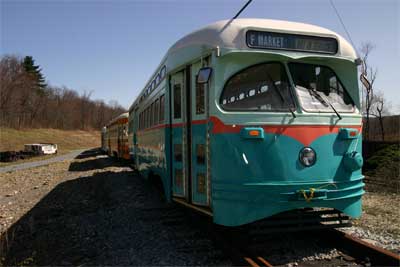 |
| The exterior of each SFMTA car is dramatically different. This car reflects the historic livery of Washington, DC. |
Using the Millermatic, Brookville mastered the rebuilding process quickly. In fact, they can finish about two cars a month. With looming deadlines, productivity is critical.
"We run the 251s for hours straight, and they never shut off," says Steele. "As long as you can hold that trigger down, it will keep running. I have guys fighting over them because they're easy to use, they run forever, and they're basically maintenance free. As long as you change your contact tip, you won't have any problems with it."
Particularly for the SEPTA project, Brookville also required spot welding capabilities. They found that with Miller's CP-252 TS and 22-A wire feeder, they could spot weld the roof of the trolley to the exterior walls.
"We cut the roofs completely off these trolleys and re-roofed them with new sheet metal," says Steele. "We then spot weld along the edges. We had up to 150 spot welds down each side of the car."
The 22-A wire feeder with Spot Control timer allows operators to get the proper heat into the metal for securely spot welding the roof to the car body. Once they became familiar with the process and tested their parameters, welding the roof was relatively simple. "You set the timer, hold your gun against the metal, pull the trigger, and it will weld for a pre-determined amount of time before it shuts off," says Steele. "It's pretty fool-proof."
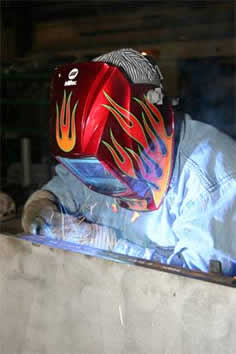 |
| Welder/fabricator Brad Smith welds heavier steel on Brookville's mining equipment line. |
TIG Tuning
When Brookville had problems MIG welding some stainless steel window frames, Gary Kahle, Account Manager for Valley Gas, recommended a Dynasty 300 DX AC/DC TIG welder "We tried another TIG machine, but we couldn't fine tune the arc enough to do the type of work we were doing, and it was much bigger and harder to move around than the Dynasty," says Brent McNeil, Production Manager.
"We don't do a lot of TIG welding, but it seems that when you need it, you really need it," adds Steele. "TIG welding is a difficult process, but the Dynasty makes it easier. The Dynasty takes a mediocre TIG welder and makes him look good." Needless to say, after a quick demo period, Brookville purchased the Dynasty for its TIG welding needs.
Phase Two
The SFMTA street car project developed in two major phases: exterior and internal rehabilitation, with each phase requiring varying amounts of work and time constraints. While the contract for SFMTA won't be completed until late 2006, the painted, "phase 1" cars are lined up outside, in back of Brookville's 72,000 square-foot facility. The cars are painted so that each car's colors resemble that of a different city.
In phase two, Brookville is rebuilding the truck assemblies, and performing interior rehabilitation; the restored cars will then be delivered to San Francisco for use on the F-Line, between the Market Street area and Fisherman's Wharf.
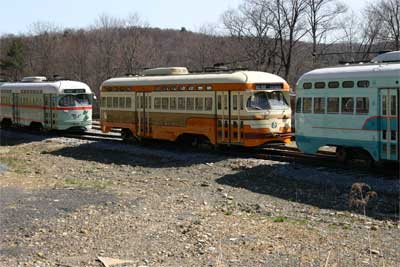 |
| The colors of these cars were chosen to resemble those of different cities (left to right): El Paso-Juarez, Cleveland and Washington, DC. |
Back to the Future
As more cities see the type of work that Brookville does, and as gas prices continue to go up, trolley and streetcar restoration contracts will rise. In fact, there are many more trolley projects out there that cities are starting up and awarding on. The SFMTA project in particular, because San Francisco trolleys are often first to come to mind, will help give higher visibility to Brookville's specialty and custom work, as well as prompt other transit authorities to evaluate the benefits of trolley and streetcar lines.
There are other benefits as well. "Cities see a lot of tourism benefits from trolley lines, and as gas prices rise, they also realize the economical and environmental benefits," adds McNeil. "It's really coming back. The history and nostalgia associated with trolleys is appealing in this day and age."
With the help of Brookville Equipment, many old trolleys and streetcars will no longer be forced into retirement, allowing a small piece of history to repeat itself.